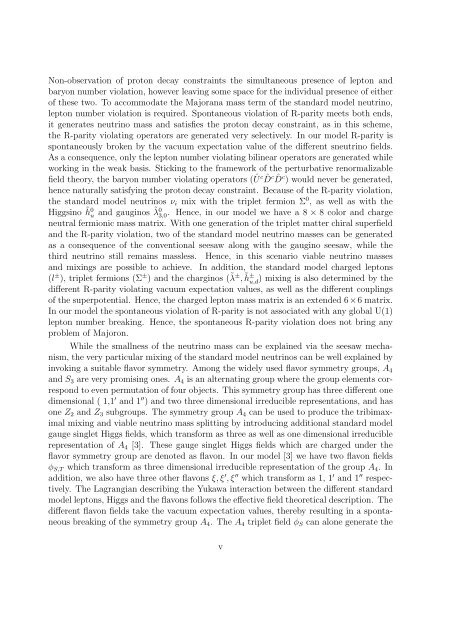PHYS08200604017 Manimala Mitra - Homi Bhabha National Institute
PHYS08200604017 Manimala Mitra - Homi Bhabha National Institute
PHYS08200604017 Manimala Mitra - Homi Bhabha National Institute
You also want an ePaper? Increase the reach of your titles
YUMPU automatically turns print PDFs into web optimized ePapers that Google loves.
Non-observation of proton decay constraints the simultaneous presence of lepton and<br />
baryon number violation, however leaving some space for the individual presence of either<br />
of these two. To accommodate the Majorana mass term of the standard model neutrino,<br />
lepton number violation is required. Spontaneous violation of R-parity meets both ends,<br />
it generates neutrino mass and satisfies the proton decay constraint, as in this scheme,<br />
the R-parity violating operators are generated very selectively. In our model R-parity is<br />
spontaneously broken by the vacuum expectation value of the different sneutrino fields.<br />
As a consequence, only the lepton number violating bilinear operators are generated while<br />
working in the weak basis. Sticking to the framework of the perturbative renormalizable<br />
field theory, the baryon number violating operators (Ûc ˆDc ˆDc ) would never be generated,<br />
hence naturally satisfying the proton decay constraint. Because of the R-parity violation,<br />
the standard model neutrinos ν i mix with the triplet fermion Σ 0 , as well as with the<br />
Higgsino ˜h 0 u and gauginos ˜λ 0 3,0 . Hence, in our model we have a 8 × 8 color and charge<br />
neutral fermionic mass matrix. With one generation of the triplet matter chiral superfield<br />
and the R-parity violation, two of the standard model neutrino masses can be generated<br />
as a consequence of the conventional seesaw along with the gaugino seesaw, while the<br />
third neutrino still remains massless. Hence, in this scenario viable neutrino masses<br />
and mixings are possible to achieve. In addition, the standard model charged leptons<br />
(l ± ), triplet fermions (Σ ± ) and the charginos (˜λ ± ,˜h ± u,d<br />
) mixing is also determined by the<br />
different R-parity violating vacuum expectation values, as well as the different couplings<br />
of the superpotential. Hence, the charged lepton mass matrix is an extended 6×6 matrix.<br />
In our model the spontaneous violation of R-parity is not associated with any global U(1)<br />
lepton number breaking. Hence, the spontaneous R-parity violation does not bring any<br />
problem of Majoron.<br />
While the smallness of the neutrino mass can be explained via the seesaw mechanism,<br />
the very particular mixing of the standard model neutrinos can be well explained by<br />
invoking a suitable flavor symmetry. Among the widely used flavor symmetry groups, A 4<br />
and S 3 are very promising ones. A 4 is an alternating group where the group elements correspond<br />
to even permutation of four objects. This symmetry group has three different one<br />
dimensional ( 1,1 ′ and 1 ′′ ) and two three dimensional irreducible representations, and has<br />
one Z 2 and Z 3 subgroups. The symmetry group A 4 can be used to produce the tribimaximal<br />
mixing and viable neutrino mass splitting by introducing additional standard model<br />
gauge singlet Higgs fields, which transform as three as well as one dimensional irreducible<br />
representation of A 4 [3]. These gauge singlet Higgs fields which are charged under the<br />
flavor symmetry group are denoted as flavon. In our model [3] we have two flavon fields<br />
φ S,T which transform as three dimensional irreducible representation of the group A 4 . In<br />
addition, we also have three other flavons ξ,ξ ′ ,ξ ′′ which transform as 1, 1 ′ and 1 ′′ respectively.<br />
The Lagrangian describing the Yukawa interaction between the different standard<br />
model leptons, Higgsandthe flavons followstheeffective field theoretical description. The<br />
different flavon fields take the vacuum expectation values, thereby resulting in a spontaneous<br />
breaking of the symmetry group A 4 . The A 4 triplet field φ S can alone generate the<br />
v
















